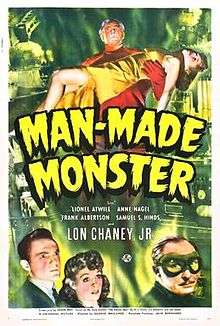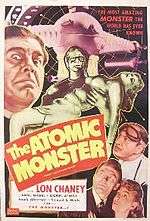Man-Made Monster
Man-Made Monster is a 1941 American black-and-white science fiction-horror film from Universal Pictures, produced by Jack Bernhard, directed by George Waggner, that stars Lon Chaney, Jr. (in his horror film debut) and Lionel Atwill. Man-Made Monster was re-released under various titles including Electric Man and The Mysterious Dr. R. Realart Pictures re-released the film in 1953 under the title The Atomic Monster as a double feature with The Flying Saucer (1950).
| Man-Made Monster | |
|---|---|
 Theatrical release poster | |
| Directed by | George Waggner |
| Produced by | Jack Bernhard |
| Screenplay by | Joseph West |
| Story by |
|
| Starring |
|
| Cinematography | Elwood Bredell |
| Edited by | Arthur Hilton |
Production company | Universal Pictures |
| Distributed by | Universal Pictures |
Release date |
|
Running time | 60 minutes |
| Country | United States |
| Language | English |
| Budget | $84,000[1] |
The plot resembles The Invisible Ray (1936), The Walking Dead (1936), and two decades later Indestructible Man (1956); that much later feature starred Chaney but was not directly inspired by Man-Made Monster.[2]
Plot
A tragic accident occurs when a bus hits a high power line. The incident has claimed the lives of all on board, except for one Dan McCormick (Lon Chaney, Jr.), who survives because he is, surprisingly, immune to the deadly electricity. McCormick does a sideshow exhibit as Dynamo Dan, the Electric Man and is taken in by Dr. John Lawrence (Samuel S. Hinds), who wants to study him. However, Dr. Lawrence's colleague, mad scientist Dr. Paul Rigas (Lionel Atwill) desires to create an army of electrobiologically-driven zombies. He gives McCormick progressively higher doses of electricity until his mind is ruined and left dependent on the addicting electrical charges. This temporarily gives McCormick the touch of death, making him capable of killing anyone he touches by electrocution. After accidentally killing Lawrence, Rigas ensures McCormick's conviction to see what will happen if he is sent to the electric chair. McCormick survives, and with a super charge in his glowing body he kills several people, including Rigas, before running out of electricity and dying.
Cast
- Lionel Atwill as Dr. Paul Rigas
- Lon Chaney, Jr. as Dan McCormick
- Anne Nagel as June Lawrence
- Frank Albertson as Mark Adams
- Samuel S. Hinds as Dr. John Lawrence
- William B. Davidson as Ralph Stanley, the district attorney
- Ben Taggart as Detective sergeant
- Constance Bergen as Nurse
- Ivan Miller as Doctor
- Chester Gan as Wong
- George Meader as Dr. Bruno
- Frank O'Connor as Detective
- John Dilson as Medical examiner
- Byron Foulger as Alienist
- Russell Hicks as Warden Harris
Production

Back in 1936, Boris Karloff was originally selected for the role of Dan McCormick, with Bela Lugosi playing Dr. Rigas. This earlier version of the film, which was titled The Electric Man, ended up being scrapped because the concept was too similar to another Karloff/Lugosi feature film, The Invisible Ray.[3] The script was then shelved for the next four years before being revived in 1940 under Universal's new management.[4] More information about the writing of the movie can be found on Tom Weaver-Constantine Nasr's "Man Made Monster" audio commentary included on Shout! Factory's 2019 Blu-ray release "Universal Horror Collection: Volume 3."
When Man-Made Monster finally went into production, the studio considered it a quick, low-budget feature. Shot in three weeks and with an estimated budget of only $86,000, it was one of the cheapest films made by Universal that year. Despite these limitations, however, the filmmakers were still able to achieve some impressive effects, including one that made Lon Chaney appear to glow in the dark.[5]
Reception
Even though it was only a minor box office success, Man-Made Monster proved to be instrumental for Lon Chaney's career; his performance in the lead role helped him win a contract with Universal.[6][7] While promoting their new star, Universal's publicity department hinted that history was possibly repeating itself, noting that Chaney's first major horror movie role was shot on the same set that was used for his father's well-known production of The Phantom of the Opera.[8]
Distribution
In the 1950s, Realart Pictures re-released the film, changing the title to The Atomic Monster in order to take advantage of the latest craze in science fiction and atomic age story lines.[9] This new title, according to writer-producer Alex Gordon, was taken from a spec script he submitted to Realart which had the same name. He sent his attorney Samuel Z. Arkoff to meet the Realart representative James H. Nicholson to discuss the matter. The meeting netted Gordon a quick $1,000 settlement for copyright infringement, but more importantly, the meeting led Gordon, Arkoff, and Nicholson to form their own film company that eventually became American International Pictures.[10]
References
- Dick, Bernard K. (2015). City of Dreams: The Making and Remaking of Universal Pictures. University Press of Kentucky. p. 117.
- Tom Weaver (2000). Return of the B Science Fiction and Horror Heroes: The Mutant Melding of Two Volumes of Classic Interviews. McFarland. p. 280. ISBN 978-0-7864-0755-2.
- Forrest Ackerman, The Frankenscience Monster Ace Books 1969
- Mank, Gregory William (2009). Bela Lugosi and Boris Karloff : the expanded story of a haunting collaboration, with a complete filmography of their films together. Jefferson, N.C.: McFarland & Co., Publishers. p. 314. ISBN 978-0786434800. Retrieved 9 November 2016.
- Hantke, ed. by Steffen (2004). Horror Film: Creating and Marketing Fear (Print on demand ed.). Jackson: Univ. Press of Mississippi. p. 200. ISBN 978-1578066926. Retrieved 9 November 2016.CS1 maint: extra text: authors list (link)
- Clarens, Carlos (1997). An illustrated history of horror and science-fiction films (New ed.). New York: Da Capo Press. pp. 101. ISBN 978-0306808005. Retrieved 9 November 2016.
- Mank, Gregory William (2001). Hollywood cauldron : thirteen horror films from the genre's golden age. Jefferson, N.C.: McFarland. p. xix. ISBN 978-0786411122. Retrieved 9 November 2016.
- Smith, Don G. (2004). Lon Chaney, Jr.: Horror Film Star, 1906-1973. McFarland & Company. p. 35. ISBN 978-0786418138. Retrieved 9 November 2016.
- Jones, edited by Darryl; McCarthy, Elizabeth; Murphy, Bernice M. (2011). It came from the 1950s! : popular culture, popular anxieties. Houndmills, Basingstoke, Hampshire: Palgrave Macmillan. p. 59. ISBN 9780230272217. Retrieved 9 November 2016.CS1 maint: extra text: authors list (link)
- Weaver, Tom (2014). Earth vs. the sci-fi filmmakers : 20 interviews. Jefferson: Mcfarland. p. 116. ISBN 978-0786495726. Retrieved 9 November 2016.
External links
| Wikiquote has quotations related to: Man-Made Monster |